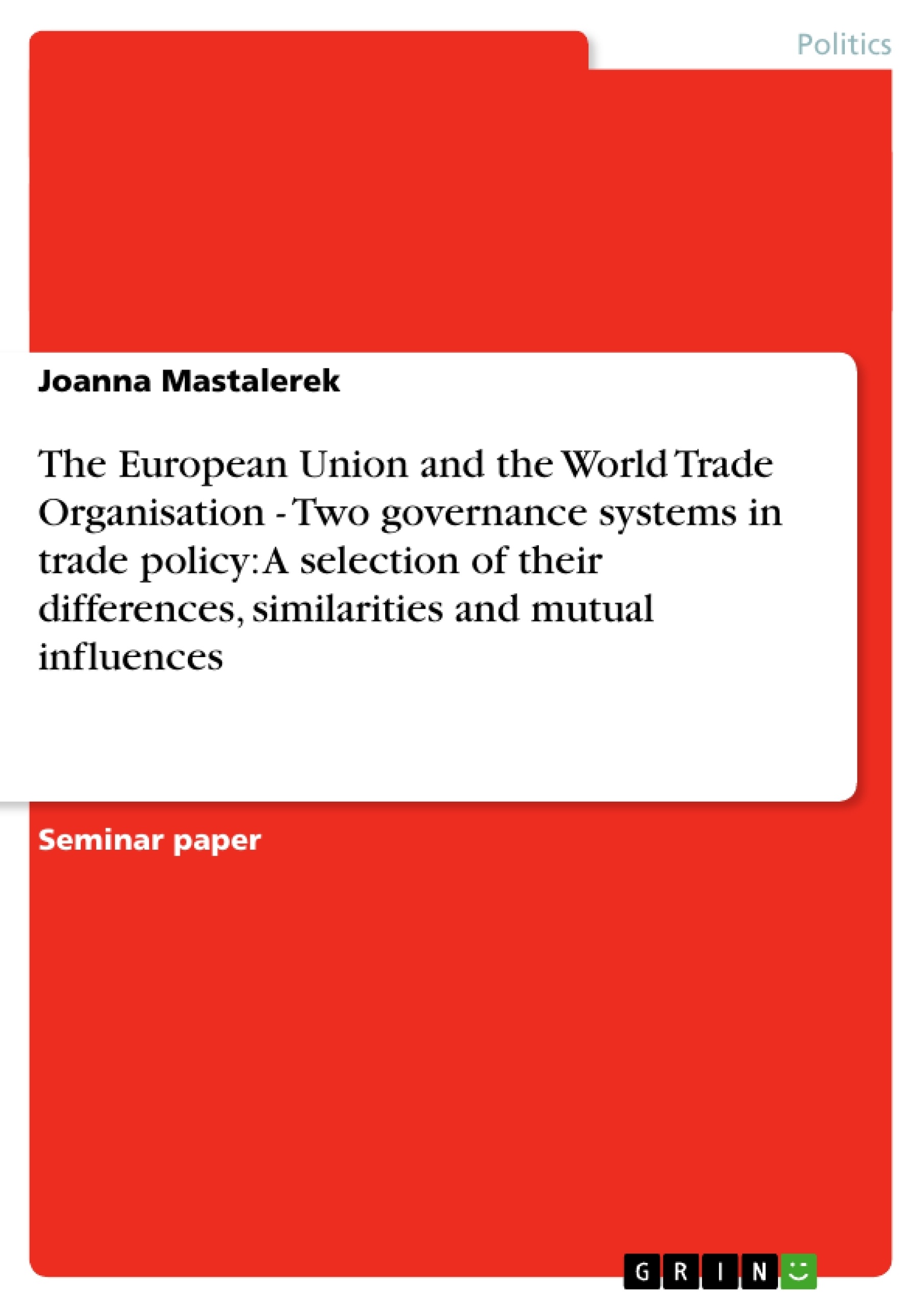In general terms, both the European Union (EU) and the World Trade Organization (WTO)
can be described as governance systems:
“Governance is about the structured ways and means in which the divergent preferences of
interdependent actors are translated into policy choices to allocate values, so that the
plurality of interests is transformed into co-ordinated action and the compliance of actors is
achieved.”1
This essay cannot reflect all aspects of the two governance systems, but is limited to a
selection of their differences, similarities and mutual influences. After the opening remark
alludes to a similarity, the differences will be touched upon next.
The individual characteristics of the EU and the WTO become particularly obvious in the
institutional set-ups of the two organisations: In the case of the EU one deals with a
supranational organisation, what means that the current 15 member states partly transfer
sovereign rights to the organisation, thus rendering the EU a partly independent and
powerful policy actor.
In comparison, the WTO is an intergovernmental organisation, in which its 146 members
negotiate without transferring any sovereignity to the organisation, thus depriving the WTO
of any independence in policy decisions 2.
The WTO is a broad international organisation, its members accounting for over 90 % of all
trade in the world, whereas the EU, being a member of the WTO, is a geographically
limited and closely integrated organisation. Even though the EU represents just 6 % of the
world’s population, it accounts for more than a fifth of global imports and exports3.
Concerning the relationship between the two organisations, their origins had an important
influence: The WTO was founded in 1995 as a successor of the General Agreement on
Tariffs and Trade (GATT) from 1947. [...]
1 Beate Kohler-Koch/ Rainer Eising (eds.): The Transformation of Governance in the European Union.
London, New York: Routledge, 1999, p. 5.
2 Mary Farrell (ed.): EU and WTO regulatory frameworks. Complementarity or competition? London: Kogan
Page, 1999, p. 44.
3 European Union: Making globalisation work for everyone.The European Union and world trade.
Luxembourg: Office for Official Publications of the European Communities, 2003, p. 4.
Inhaltsverzeichnis (Table of Contents)
- Institutional set-up of the EU and the WTO
- Common aims of the EU and the WTO
- Designing EU trade Policy related to the WTO
- WTO principles affecting EU trade policy
- Differences in the legal authorities of the WTO and the EU
- Positive and negative integration: views of trade policy in the EU and the WTO
- Conclusion
Zielsetzung und Themenschwerpunkte (Objectives and Key Themes)
This essay examines the European Union (EU) and the World Trade Organization (WTO) as governance systems in trade policy, highlighting their differences, similarities, and mutual influences. It explores how these two organizations, despite their distinct structures, share common aims and objectives, particularly in promoting multilateral trade and fostering economic growth.
- Institutional set-up and differences between the EU and the WTO
- Shared objectives and aims of the EU and the WTO
- The role of the WTO principles in shaping EU trade policy
- Comparison of the legal authorities of the EU and the WTO
- Exploring the concepts of positive and negative integration in the context of trade policy within both organizations
Zusammenfassung der Kapitel (Chapter Summaries)
- Chapter 1: Institutional set-up of the EU and the WTO: This chapter delves into the fundamental differences in the institutional structures of the EU and the WTO. It defines both as governance systems and explores how the EU's supranational structure, where member states transfer sovereignty, contrasts with the WTO's intergovernmental setup, where sovereignty remains with its members. The chapter also highlights the geographical differences between the two organizations, noting the EU's regional focus and the WTO's global reach.
- Chapter 2: Common aims of the EU and the WTO: This chapter identifies the shared goals of the EU and the WTO, focusing on their commitment to promoting multilateral trade, removing trade barriers, and fostering economic growth. It highlights the Treaty of Rome's Article 133 as a testament to the EU's commitment to these objectives.
- Chapter 3: Designing EU trade Policy related to the WTO: This chapter examines the intricate relationship between the EU's trade policy and the WTO. It explains how the EU has established the Common Commercial Policy, under which the European Commission negotiates trade agreements on behalf of all EU members. It also details the roles of the Article 133 Committee, the European Parliament, and civil society in shaping EU trade policy.
Schlüsselwörter (Keywords)
This essay explores the core concepts of globalisation and European governance, specifically focusing on the European Union (EU) and the World Trade Organization (WTO) as distinct yet intertwined governance systems in trade policy. The key topics examined include the institutional differences, common aims, WTO principles impacting EU trade policy, legal authorities, and the concepts of positive and negative integration.
- Arbeit zitieren
- Joanna Mastalerek (Autor:in), 2004, The European Union and the World Trade Organisation - Two governance systems in trade policy: A selection of their differences, similarities and mutual influences, München, GRIN Verlag, https://www.grin.com/document/23845



